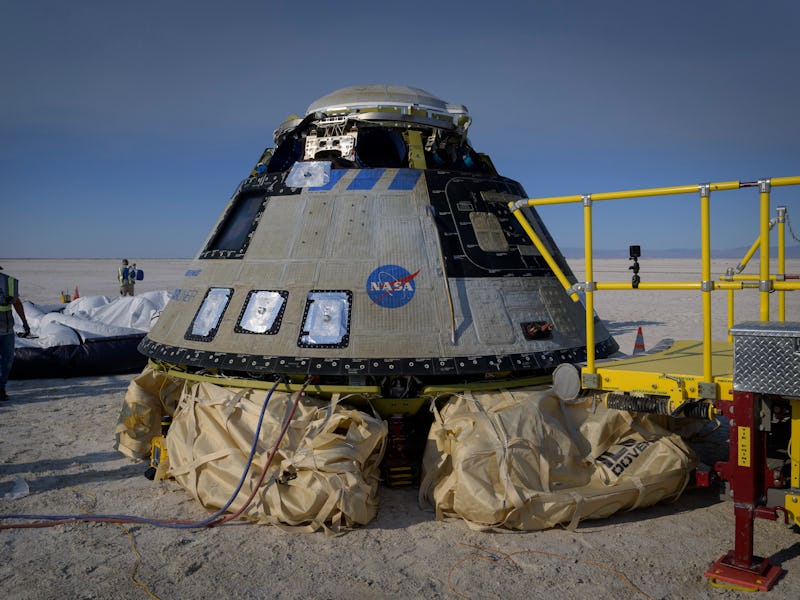Boeing’s Starliner lands in the desert — and brings NASA one step closer to a key strategic goal
Starliner’s path to success has been turbulent.

Had you been in Baja, Sonora, or New Mexico on late Wednesday afternoon local time, you might have seen a trail across the sky from the southwest. It was an uncrewed test flight of Boeing’s Starliner capsule, returning to Earth after a successful visit to the International Space Station.
This flight has been a long time coming. It brings NASA one step closer to a goal it’s had for some years now: To rely on multiple private space companies to transport astronauts and supplies between the ground and the ISS. But Starliner’s path has been turbulent. For NASA, even if the ascent was a success, it was still well behind schedule.
This mission, evocatively named Orbital Flight Test 2 (OFT-2), launched on an Atlas V rocket from Cape Canaveral on May 19 and arrived at the ISS on May 21. The capsule received a warm welcome from the astronauts currently aboard the station: three Russians, three Americans, and Italian ESA astronaut Samantha Cristoforetti.
Over a decade ago as the venerable Space Shuttles entered retirement, NASA found itself without a mode of transport to the ISS. To remedy this, NASA bought its astronauts seats aboard Russian Soyuz flights — a time that seems so quaint today. Even as the agency found its hands empty, however, they were seeking aerospace companies to fill the void.
In 2014, NASA chose two firms — SpaceX and Boeing — to simultaneously build different “space taxis.” SpaceX’s entry would become its Crew Dragon capsule, while Boeing’s entry would become the Starliner. At the time, NASA said that they wanted the capsules to ferry astronauts to and fro the ISS by 2017.
It was 1:36 PM CDT on Wednesday, May 26, 2022, when this Starliner — still uncrewed — set off from the ISS. It began to fire its thrusters to put some initial distance between itself and the station.
Even as early as the 2010s, NASA wanted multiple companies for transport, as this would give the agency multiple options. In the event one launch vehicle goes awry, as spacecraft can so often do, NASA can still rely on a second without too much disruption.
But there’s a deeper motive, wrapped in market rhetoric. NASA’s 2018 Strategic Plan states that it strives to “maintain a constant human presence in low Earth orbit enabled by a commercial market.” NASA believes that achieving this goal means using multiple companies. Its picks are already expanding to private spaceflight: SpaceX flew private astronauts to the ISS in April, and Boeing has left the possibility open.
NASA officials have stated similar intent in seeking providers for its Moon-bound Artemis program. “When we go to the moon, we want to be one customer of many customers in a robust marketplace between the Earth and the moon,” then-NASA Administrator Jim Bridenstine said in November 2018. “We want multiple providers that are competing on cost and innovation.”
At 5:05 CDT, the Starliner fired its thrusters, forcing it out of Earth orbit, beginning the long plunge down to Earth’s surface. As it entered the atmosphere, it was traveling at 14 times the speed of sound, according to NASA’s Livestream of the landing.
Schedule delays are hardly unexpected in the aerospace world, and neither SpaceX nor Boeing met that initial 2017 deadline. For SpaceX’s part, after an explosion in May 2019 during a pad test, Crew Dragon completed its first crewed flight in November 2020—delivering three Americans and one Japanese astronaut to the ISS.
Starliner’s journey to orbit was no less tumultuous. This May 2022 flight perhaps should have happened in December 2019. Then, as now, Boeing and NASA tried to launch the Starliner without a crew. But a software glitch caused the thrusters to misfire, sending Starliner into the wrong orbit. It was brought down without ever reaching the ISS.
The company tried again in July 2021. But when the capsule was on the launchpad, just hours before scheduled takeoff, Boeing called it off — blaming malfunctioning propellant valves.
It took Boeing nearly a year to solve the issues. But this most recent launch was successful, and so was the capsule’s re-entry.
After it surged through the upper layers of the atmosphere, Starliner threw open two initial drogue parachutes. They cut enough speed to allow the craft to deploy its three main parachutes. Those slowed the shooting spacecraft down to the speed of a gently descending elevator. The spacecraft then cast away the heat shield at its base, unveiling giant airbags for a gentle landing.
At 5:49 CDT, the craft touched down at White Sands in the New Mexico desert, next to an unused runway that the Space Shuttle Columbia once used. Since the capsule landed in a planned location, near an inhabited location, on land, NASA and Boeing technicians could reach the site in mere minutes.
Now that they know the system can work, Starliner’s stewards and NASA officials are looking forward to an even larger milestone: the capsule’s first crewed test. That could happen as early as this year.
This article was originally published on